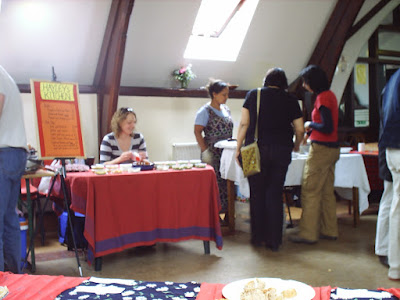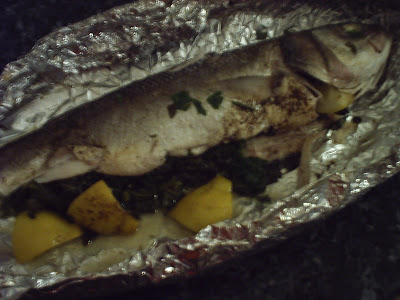Due to the rain, the market was held indoors again, under the church-turned-Asian-cultural-centre roof that makes for a cozy atmosphere. Graeme and I had a cute corner table in between the farmers who sell produce (and who had the most gorgeous flat beans, that I mistook for broad beans because I am ignorant, in the world yesterday), and the farmer who sells eggs, milk, meat, and other goodies. I should mention that we've been buying her milk lately, in its lovely tall glass bottles, and it is the first time IN MY LIFE that I have been excited about milk. It is thick and creamy and just...full of taste, and I have no patience for supermarket milk anymore. She has spoiled me (no pun intended!) for other milks.
Here is a shot of our neighbours, the produce farmers:
 I should mention that these folks are generally the nicest people ever, but they were particular in our good books yesterday, as the female farmer bounded up to us at the beginning of the market telling us that she'd bought a few of our bagels last time, and that they were incredible. so this time she bought A DOZEN BAGELS, saying she would freeze them to hold her over for a couple of weeks. This is the most bagels anyone has ever bought from us, and we were so flattered! And if I do say so myself, I make an awesome fucking bagel.
I should mention that these folks are generally the nicest people ever, but they were particular in our good books yesterday, as the female farmer bounded up to us at the beginning of the market telling us that she'd bought a few of our bagels last time, and that they were incredible. so this time she bought A DOZEN BAGELS, saying she would freeze them to hold her over for a couple of weeks. This is the most bagels anyone has ever bought from us, and we were so flattered! And if I do say so myself, I make an awesome fucking bagel.Here is a shot of the tables directly across from us:
 Pictured here you'll see Hayley, who makes the best dips and pestos I have yet to taste in this town. We bought two pestos from her (one with pumpkin seeds, one with almond and parsley), and one tin of feta and broccoli dip. Hayley is in our good books because the last time we sold at the market, it started pissing down rain as soon as we all meant to leave, and she gave us a lift back to my house. Also she's really nice. Next to her, you can see Carla's cakes and other baked goods--we ate a couple of samosas from her for lunch yesterday, and they were killer. She also had the world's most beautiful strawberry cheesecake. Our friendly egg/milk/meat farmers are pictured there, buying from her.
Pictured here you'll see Hayley, who makes the best dips and pestos I have yet to taste in this town. We bought two pestos from her (one with pumpkin seeds, one with almond and parsley), and one tin of feta and broccoli dip. Hayley is in our good books because the last time we sold at the market, it started pissing down rain as soon as we all meant to leave, and she gave us a lift back to my house. Also she's really nice. Next to her, you can see Carla's cakes and other baked goods--we ate a couple of samosas from her for lunch yesterday, and they were killer. She also had the world's most beautiful strawberry cheesecake. Our friendly egg/milk/meat farmers are pictured there, buying from her.Other warm and fuzzy moments at the market yesterday included a customer who came up to us and asked straight away for some pierogi. This is a rarity at the market, as we tend to find that folks are only adventurous to a degree-they'll try something a little bit new, but something as completely new to them as pierogi (which the British have yet to really discover), is just too scary. We never tend to sell too many bags of pierogi. This particular customer explained that she'd bought some to try last time, and just loved them, and so was excited to buy some more. I am easily flattered and this made my day.
The bagels and scones sold nicely. The cheese scones were much appreciated, and the woman who had originally requested them honed in on them immediately and bought a bunch of them. Pictured here is Graeme with our scones and bagels, and a sleepy smile:
 Our most popular item, it seems, are my cornbread muffins. This is a mystery to both me and Graeme, as cornbread is the easiest to make, and likely the least impressive of our wares. But this is the second time in a row that we've sold out of them, and I made a third more muffins than I did last time. People love them, and some allergic folk appreciate that they're gluten free. So in contradiction to what I said about people's lack of adventurousness above, these appear to be something that most people had never had before (cornbread is, again, largely unknown to the British), but that have been a huge hit. Up with cornbread.
Our most popular item, it seems, are my cornbread muffins. This is a mystery to both me and Graeme, as cornbread is the easiest to make, and likely the least impressive of our wares. But this is the second time in a row that we've sold out of them, and I made a third more muffins than I did last time. People love them, and some allergic folk appreciate that they're gluten free. So in contradiction to what I said about people's lack of adventurousness above, these appear to be something that most people had never had before (cornbread is, again, largely unknown to the British), but that have been a huge hit. Up with cornbread.One more thing that we should mention about the market, and how much we love selling there--it is packed with awesome, cute, funny, sweet, kids. There is one little girl who must be about three years old, who is a little chatterbox and loves to run up to us and talk about cakes--ones she's eaten, and ones she will eat. Yesterday she and her dad seemed fairly efficient in their shopping so we didn't get to hang out with her much, but we still got a little smile and a wave. We were not lacking for children, though. From the moment we started setting up, the daughter of the lovely couple who have a fair trade products stall at the market (and who love our cornbread), ran up to us and decided that our stall was her favourite, and insisted on hanging with us for most of the market, donning our plastic gloves, and being our little helper. You can see eight-year-old Bella pictured here with me, as long as you ignore my very strange facial expression:
 Bella thought our bagels were our tastiest treat, and helped me pack customers' purchases into our big paper bags. She also made up stories about witches and clowns by messing with her plastic gloves. Cutest kid.
Bella thought our bagels were our tastiest treat, and helped me pack customers' purchases into our big paper bags. She also made up stories about witches and clowns by messing with her plastic gloves. Cutest kid.Talking about it afterwards, Graeme and I decided that farmers' market kids are the best kids ever--our little helper, for example, was chatty and energetic, but also so incredibly well behaved--she always followed our hygiene rules while helping me sell stuff, she never messed around with anything, she was patient when we were dealing with customers (and always piped in to make her own recommendations!), and was just... perfect. We've noticed this with all of our interactions with the market kids, who usually befriend each other quick and run around the market playing games while their parents buy them treats. It's ridiculously idyllic.
Which can be said of the market itself. June 9th will be the last time Graeme and I sell at it, as we'll soon be leaving Oxford. This has us feeling rather wistful. The market has been a lovely community to us, and this is where it succeeds the most--it is not only a place to purchase high quality, healthy, affordable foods, but it is also a gathering place, where people sit, chat, play, laugh, and befriend one another. We love the ethos of the place--it is small enough to welcome even amateurs like us, and we love the mix of professional farmers, and amateur cooks, all of whom come together for a delicious weekly event. We love how kind everyone is, how excited people get about their food, and how laid back the whole event is. We've been reading lately about a lot of the accusations of pretension about organic food culture, and while we both participate in said culture, we agree that a lot of the class issues inherent in it make us pretty uncomfortable. But our lovely Saturday market is just a bunch of folks, young and old, yuppy and hippie, farmer and amateur, family and student, light-skinned and dark-skinned, of a variety of incomes, getting together to eat happily and ethically. We hope that we'll find something like this back in Canada, but we're not sure--this market is amazing entirely for its ad hoc, bottom up nature. We love it.
















